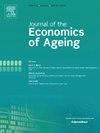Growing old in rural America: Measuring late-life health and economic well-being
IF 2
3区 经济学
Q2 DEMOGRAPHY
引用次数: 0
Abstract
We estimate well-being among older rural Americans with an expected utility framework and simulations using longitudinal data spanning nearly 30 years from the Health and Retirement Study. At age sixty, we find mean rural consumption expenditures of $24,105, a retirement probability of 53%, and a remaining life expectancy of 20.3 years for the cohort born 1931–36. When adjusting life expectancy for living in poor health, we obtain an age sixty quality adjusted life expectancy (QALE) of only 15.4 years. Our welfare metric suggests well-being among rural residents who report loneliness is only about half that of the non-lonely rural residents—largely driven by substantial consumption and QALE gaps. We also document substantial regional variation in rural well-being. Moreover, we find that older rural Americans are generally falling further behind older urban Americans across birth cohorts. Most of this widening gap is driven by declining relative consumption and wealth as opposed to health.
美国农村的老龄化:衡量晚年健康和经济福祉
我们用一个预期的效用框架来估计美国农村老年人的福祉,并使用健康与退休研究中近30年的纵向数据进行模拟。在60岁时,我们发现平均农村消费支出为24,105美元,退休概率为53%,1931-36年出生的人群的剩余预期寿命为20.3年。当调整健康状况不佳的预期寿命时,我们得到60岁的质量调整预期寿命(QALE)只有15.4年。我们的福利指标显示,报告孤独的农村居民的幸福感只有非孤独农村居民的一半左右,这主要是由巨大的消费和生活质量差距造成的。我们还记录了农村福利的重大区域差异。此外,我们发现,在整个出生队列中,老年农村美国人普遍落后于老年城市美国人。这种不断扩大的差距主要是由相对消费和财富的下降而不是健康造成的。
本文章由计算机程序翻译,如有差异,请以英文原文为准。
求助全文
约1分钟内获得全文
求助全文
来源期刊

Journal of the Economics of Ageing
Multiple-
CiteScore
4.10
自引率
4.50%
发文量
46
审稿时长
49 days
期刊介绍:
The Journal of the Economics of Ageing (JEoA) is an international academic journal that publishes original theoretical and empirical research dealing with the interaction between demographic change and the economy. JEoA encompasses both microeconomic and macroeconomic perspectives and offers a platform for the discussion of topics including labour, health, and family economics, social security, income distribution, social mobility, immigration, productivity, structural change, economic growth and development. JEoA also solicits papers that have a policy focus.
 求助内容:
求助内容: 应助结果提醒方式:
应助结果提醒方式:


